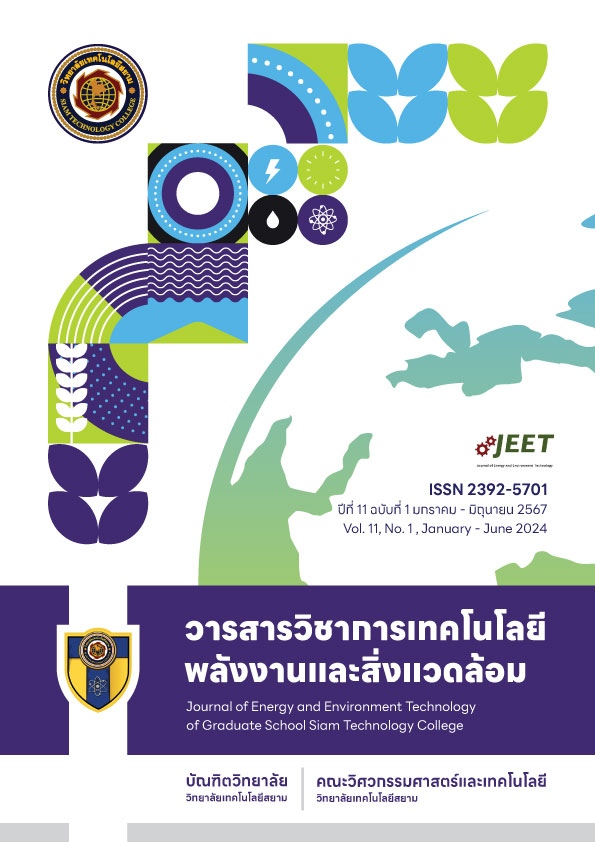การคาดการณ์การใช้พลังงานของรถยนต์ไฟฟ้าพลังงานแสงอาทิตย์ STC-4 สำหรับการเดินทางในเส้นทางการแข่งขันรายการ Bridgestone World Solar Challenge
Main Article Content
บทคัดย่อ
งานวิจัยนี้มีวัตถุประสงค์ในการคาดการณ์อัตราสิ้นเปลืองพลังงานของรถยนต์ไฟฟ้าพลังงานแสงอาทิตย์ STC-4 สำหรับการเดินทางในเส้นทางการแข่งขันรายการ Bridgestone World Solar Challenge โดยใช้ข้อมูลเส้นทางการแข่งขัน เริ่มต้นจากเมืองดาร์วิน ซึ่งอยู่ทางภาคเหนือของประเทศออสเตรเลีย จนถึงเมืองแอดิเลด ซึ่งอยู่ทางภาคใต้ของประเทศออสเตรเลีย ระยะทางรวมทั้งสิ้น 3,039.42 กิโลเมตร ใช้ระยะเวลาในการเดินทาง 6 วัน ผลการวิเคราะห์ค่าการใช้พลังงานของรถยนต์ไฟฟ้าพลังงานแสงอาทิตย์ STC-4 พบว่า วันที่ 1 จุดเริ่มต้น Merrill Corporation Australia สิ้นสุด Larrimah Hotel and Caravan Park ระยะทางทั้งสิ้น 497.66 กิโลเมตร ใช้พลังงานสะสม 28,449.47 วัตต์ชั่วโมง วันที่ 2 จุดเริ่มต้น Larrimah Hotel and Caravan Park สิ้นสุด Tennant Creek – Outback Caravan Park ระยะทางทั้งสิ้น 492.21 กิโลเมตร ใช้พลังงานสะสม 28,543.50 วัตต์ชั่วโมง วันที่ 3 จุดเริ่มต้น Tennant Creek – Outback Caravan Park สิ้นสุด Alice Springs Heritage Caravan Park ระยะทางทั้งสิ้น 514.34 กิโลเมตร ใช้พลังงานสะสม 30,447.40 วัตต์ชั่วโมง วันที่ 4 จุดเริ่มต้น Alice Springs Heritage Caravan Park สิ้นสุด Oasis Tourist Park ระยะทางทั้งสิ้น 683.7 กิโลเมตร ใช้พลังงานสะสม 39,034.06 วัตต์ชั่วโมง วันที่ 5 จุดเริ่มต้น Oasis Tourist Park สิ้นสุด Augusta Caravan Park ระยะทางทั้งสิ้น 548.11 กิโลเมตร ใช้พลังงานสะสม 31,980.70 วัตต์ชั่วโมง วันที่ 6 จุดเริ่มต้น Augusta Caravan Park สิ้นสุด Adelaide Victoria Square ระยะทางทั้งสิ้น 303.4 กิโลเมตร ใช้พลังงานสะสม 17,984.24 วัตต์ชั่วโมง
Article Details

อนุญาตภายใต้เงื่อนไข Creative Commons Attribution-NonCommercial-NoDerivatives 4.0 International License.
เนื้อหาและข่อมูลในบทความที่ลงตีพิมพ์ในวารสารวิชาการ เทคโนโลยี พลังงาน และสิ่งแวดล้อม บัณฑิตวิทยาลัย วิทยาลัยเทคโนโลยีสยาม ถือเป็นข้อคิดเห็นและความรับผิดชอบของผู้เขียนบทความโดยตรง ซึ่งกองบรรณาธิการวารสารไม่จำเป็นต้องเห็นด้วย หรือว่าร่วมรับผิดชอบใด ๆ
บทความ ข้อมูล เนื้อหา รูปภาพ ฯลฯ ที่ได้รับการตีพิมพ์ในวารสารวิชาการ เทคโนโลยี พลังงาน และสิ่งแวดล้อม บัณฑิตวิทยาลัย วิทยาลัยเทคโนโลยีสยาม ถือเป็นลิขสิทธิ์ของวารสารวิชาการ เทคโนโลยี พลังงาน และสิ่งแวดล้อม บัณฑิตวิทยาลัย วิทยาลัยเทคโนโลยีสยาม หากบุคคล หรือหน่วยงานใดต้องการนำทั้งหมด หรือส่วนหนึ่งส่วนใดไปเผยแพร่ต่อ หรือเพื่อกระทำการใด ๆ จะต้องได้รับอนุญาต เป็นลายลักษณ์อักษรจากวารสารวิชาการ เทคโนโลยี พลังงาน และสิ่งแวดล้อม บัณฑิตวิทยาลัย วิทยาลัยเทคโนโลยีสยาม เท่านั้น
เอกสารอ้างอิง
South Australian Motor Sport Board. (2024). History (Online). Available : https://worldsolarchallenge.org/the-event/history. Retrieved 21 March 2024.
South Australian Motor Sport Board. (2024). Regulations (Online). Available : https://worldsolarchallenge.org/the-event/2023_regulations. Retrieved 4 April 2024.
X. Shao et al. (2016). Solar irradiance forecasting by machine learning for solar car races, IEEE International Conference on Big Data (Big Data), Washington, DC, USA, 2016, pp. 2209-2216.
Lynn H. Kaack, George H. Chen, M. Granger Morgan. (2019). Truck traffic monitoring with satellite images, ACM SIGCAS International Conference on Computing and Sustainable Societies (COMPASS), Accra, Ghana. ACM, New York, USA, 2019, pp. 155-164.
GNU Affero General. (2024). Facilmap (Online). Available: https://facilmap.org/#6/-33.989/136.318/Mpnk/-32.516234%2C137.837375%20to%20-34.927162%2C138.599850%20by%20car%20details. Retrieved 4 April 2024.
เกรียงศักดิ์ พราหมณ์พันธุ์. (2544). การทำแผนที่สามมิติ. ชลบุรี: มหาวิทยาลัยบูรพา.
เผด็จ แสนเกษม. (2558). วิศวกรรมยานยนต์. กรุงเทพฯ: บริษัท สำนักพิมพ์ท้อป จำกัด.
S.C. Yang, M. Li, Y. Lin, T.Q. Tang. (2014). Electric vehicle’s electricity consumption on a road with different slope, Journal of ELSEVIER, Physica A 402, 41-48.


